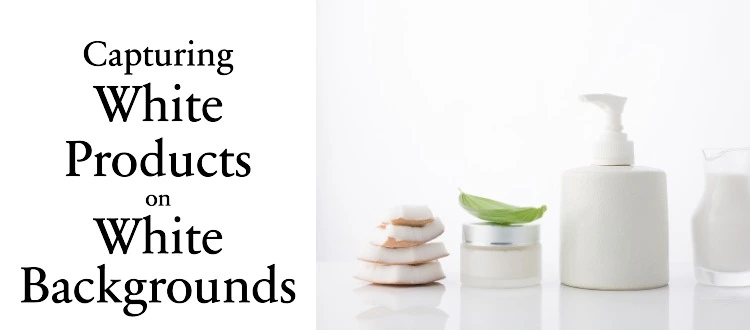Theodore Lowe, Ap #867-859
Sit Rd, Azusa New York
Find us here
Capturing White Products on White Backgrounds: Master Techniques

It might seem like a daunting task, but you're about to discover how to turn this challenge into an opportunity to showcase your products in their purest form. Do your product images look washed out or invisible? You're not alone, and we're here to help you master the art of photographing white on white.
This guide will unlock the secrets to creating striking images that captivate your audience and drive sales. Keep reading to transform your product photography skills and make your products stand out, even against the starkest of backdrops.
Lighting Techniques
Capturing white products on white backgrounds is a unique challenge. Lighting techniques play a crucial role in achieving the perfect shot. Mastering these techniques ensures your product stands out while maintaining its natural appeal. Proper lighting helps create contrast and definition. It prevents the product from blending into the background. Let's explore some essential lighting techniques.
Soft Lighting
Soft lighting is essential for capturing white products. It minimizes harsh shadows and highlights. Use softboxes or umbrellas for diffused light. These tools spread light evenly across the product. The result is a gentle, even illumination. This technique prevents overexposure and maintains detail. Soft lighting enhances the product's features without overpowering them.
Diffusion Methods
Diffusion methods help soften the light. They reduce glare and reflections. Use materials like diffusion panels or translucent sheets. Place them between the light source and the product. This creates a smooth, even light. Diffusion methods ensure the product's true colors shine through. They help maintain a natural look.
Avoiding Shadows
Shadows can be distracting in product photography. Position lights strategically to avoid them. Use multiple light sources for even coverage. Place lights at different angles around the product. This technique minimizes shadows and highlights important features. Reflective surfaces can also help. They bounce light back onto the product. This reduces shadow intensity and enhances clarity.
Camera Settings
Achieving perfect shots of white products on white backgrounds requires careful camera settings. Adjust exposure and ISO to prevent images from appearing washed out. Utilize lighting techniques to enhance product details, ensuring clarity and precision in every capture.
Capturing white products on a white background can seem daunting. However, with the right camera settings, you can achieve crisp, professional results. Let's dive into some essential settings that will help you master this photography challenge.
White Balance Adjustments
White balance ensures that the colors in your photos look natural and true to life. When shooting white on white, this becomes even more crucial. Set your camera to a custom white balance to prevent any color cast from affecting your product's appearance. A simple gray card can help in getting accurate white balance. Place it in the scene, take a photo, and adjust your settings accordingly. This small step can elevate your photos significantly.
Exposure Control
Exposure is all about how light or dark your image will be. When everything is white, it’s easy for your camera to get confused and underexpose the image. Use exposure compensation to brighten your shots. Try starting with a +1 or +2 exposure adjustment. This often helps in retaining the details of the product without losing them to overexposure. Remember to check your histogram to ensure you’re capturing all the necessary details.
Aperture Choices
Aperture controls the depth of field in your images. For product photography, a higher f-stop (like f/8 or f/11) is often ideal. It keeps the entire product in sharp focus. However, consider experimenting with different apertures. Sometimes a lower f-stop can create a soft background that makes your product stand out. Have you tried different settings to see which makes your product pop? Adjusting your camera settings may seem like a small detail, but it can make a big difference. Experiment, learn, and soon capturing white products on a white background will be second nature to you.
Background Selection
Capturing white products on white backgrounds demands precision in lighting and angles. Proper setup highlights product details effectively. This technique enhances the product's clean and professional appearance.
Capturing white products against a white background can seem daunting at first, but the right background selection can make a world of difference. It’s not just about picking any white surface; it's about choosing one that complements your product without blending it into oblivion. This task requires a keen eye and a touch of creativity. Let’s dive into how you can make your white-on-white photography truly stand out.
Choosing The Right White
Not all whites are created equal. When selecting a white background, consider the shade and tone. Pure white might seem like the obvious choice, but sometimes an off-white, like ivory or eggshell, can add depth and contrast. Imagine photographing a sleek white watch. Pairing it with a slightly warmer white background can help the watch's details pop. What’s your go-to shade for a striking contrast?
Texture Considerations
Texture plays a crucial role in background selection. A smooth, glossy surface offers a modern, sleek look, while a matte finish provides a softer, more understated effect. Each texture can highlight different aspects of your product. A personal favorite is using a satin-like backdrop for ceramic items. The sheen creates an elegant glow, showcasing the product’s craftsmanship. Which texture do you think would enhance your product’s features?
Using Reflective Surfaces
Reflective surfaces can create stunning visual effects. They introduce subtle reflections, adding dimension and drama to your shots. This technique can be especially effective for products with intricate details. Consider photographing a white perfume bottle. A reflective surface can mirror its delicate curves, creating a sense of luxury and sophistication. How might reflections transform your product photography? Remember, the key is to experiment and find what works best for your specific product. Each choice you make in background selection adds a layer of creativity and professionalism to your images.
Composition Strategies
Capturing white products on white backgrounds is a unique challenge. It requires precision in composition. The right composition strategies make your images stand out. They ensure products appear clear and attractive. Proper composition can transform a simple photo into a captivating image. Let's explore some key composition strategies.
Framing Techniques
Framing enhances focus on your product. Use props or shadows to create a frame. This helps guide the viewer's eye to the product. Frames should complement the product, not overpower it. Experiment with different angles. It adds depth and interest to the image.
Focal Points
Every photo needs a clear focal point. For white-on-white, this is crucial. Use lighting to highlight the product's features. Contrast can also help in defining the focal point. Ensure the product is the main attraction. Avoid distractions in the background.
Balancing Elements
Balance is key in photography. It creates harmony in your image. Use symmetry to balance the composition. Asymmetry can work too, for a dynamic look. Place elements thoughtfully in the frame. Keep the product central and prominent. This ensures visual balance and appeal.
Common Challenges
Photographing white products against white backgrounds presents unique challenges. Ensuring the product stands out requires careful lighting and contrast adjustments. Achieving crisp, clear images often demands meticulous attention to detail in exposure and shadow play.
Capturing white products on white backgrounds presents unique challenges. Photographers often struggle to differentiate the product from its backdrop. This can lead to images that lack depth and clarity. Let's explore some common issues faced during this process.
Avoiding Overexposure
Overexposure can wash out product details. White products on white backgrounds are especially prone to this issue. Light sources need careful control. Too much light can make the product blend with the background. Use diffusers to soften the light. This helps in maintaining clarity. Experiment with different settings to find a balance.
Maintaining Product Details
Details of the product can get lost. White-on-white settings often dull the product's features. Adjusting the camera settings can help. Use a higher f-stop to increase focus depth. This ensures every detail is sharp and clear. Consider using a macro lens for smaller items. It captures intricate details better.
Dealing With Reflections
Reflections can distort the image. White products can reflect the light. This creates unwanted glare or shadows. Position the lights at different angles. Reduce direct reflections on the product. Using polarizing filters can also help. They minimize glare and enhance image quality. Practice and adjustments are key to mastering reflections.
Conclusion
Capturing white products on white backgrounds requires patience and skill. Practice makes it easier. Use proper lighting to enhance the product's features. Adjust your camera settings for clear, vibrant shots. Experiment with angles and compositions. Editing tools can refine your images further.
Consistency in photography style builds a strong brand image. Remember to keep it simple and clean. Your efforts will pay off in stunning, professional photos.
Related blog posts
Creating a Kid-Friendly Studio Setup: Ultimate Guide
Imagine capturing the pure joy and energy of children in your clothing photography. Sounds exciting, right?

QR Codes in Photography: Unlocking Creative Possibilities
Imagine transforming your photography into an interactive experience that captivates your audience. QR codes are revolutionizing the way we share and engage with images.


